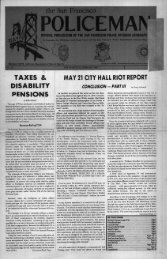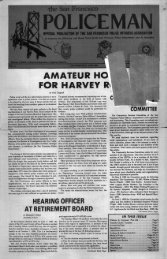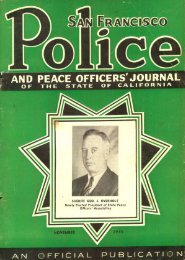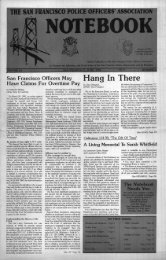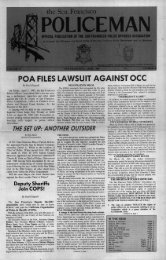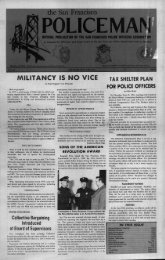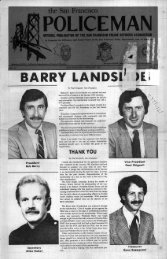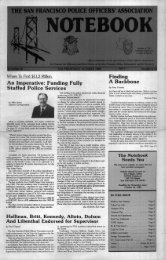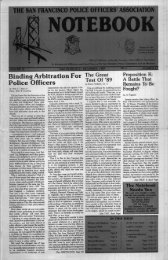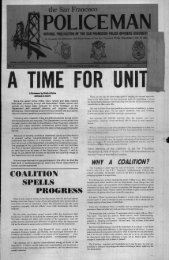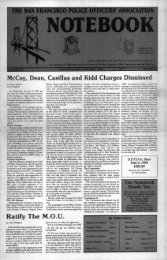August 1989 - San Francisco Police Officers Association
August 1989 - San Francisco Police Officers Association
August 1989 - San Francisco Police Officers Association
- No tags were found...
Create successful ePaper yourself
Turn your PDF publications into a flip-book with our unique Google optimized e-Paper software.
<strong>August</strong>, <strong>1989</strong> Notebook Page 11<br />
Jerry DA rcy<br />
A Man For All Seasons<br />
by Paul Chignell<br />
Vice President<br />
Gerald C. D'Arcy, one of the great police<br />
union leaders in the United States, passed<br />
away recently after a brief illness.<br />
Most <strong>San</strong> <strong>Francisco</strong> police officers know<br />
the name of D'Arcy as a retired <strong>Police</strong><br />
Commander (1985) and as the father of<br />
two distinguished police officers in <strong>San</strong><br />
<strong>Francisco</strong>, Brian and Jerry Jr.<br />
Though Jerry D'Arcy was an excellent<br />
police officer upon his entry to the Department<br />
in 1953 until his retirement in 1985<br />
after attaining the rank of Commander, his<br />
legacy will certainly include his tremendous<br />
talent as a leader in the police union movement<br />
of the late 1960s and early 1970s.<br />
Jerry D'Arcy was a man of vision - a<br />
man who transformed the <strong>Police</strong> <strong>Officers</strong>'<br />
<strong>Association</strong> from a fraternal organization<br />
into one of the most powerful rank and file<br />
police organizations in America. He had<br />
allies within The POA in the early years,<br />
cops like Jerry Crowley, Tom Carey, Lou<br />
Calabro, Mario Tovani and others. But it<br />
was the leadership of Jerry D'Arcy, a man<br />
with a purpose, that led to the transformation<br />
of the POA.<br />
D'Arcy helped form the Bluecoats, a<br />
tightly knit group of officers who believed<br />
that the POA was not representative of the<br />
officers wearing blue uniforms in the district<br />
stations. They spearheaded changing the<br />
POA by-laws so that each of the stations<br />
and units would have representation on the<br />
POA Board of Directors. Their first major<br />
issue in 1969 was to obtain equity in like<br />
work/like/pay cases as they found that<br />
many of their members were being passed<br />
over for these assignments. They won that<br />
battle.<br />
In 1970 Jerry D'Arcy was elected 2nd<br />
Vice-President of the POA and continued<br />
to persist in recruiting Bluecoats to fill the<br />
other offices of the <strong>Police</strong> <strong>Officers</strong>'<strong>Association</strong>.<br />
He and Jerry Crowley led a massive<br />
demonstration of off-duty officers in June<br />
of 1970 marching around the Civic Center<br />
plaza wearing black arm bands protesting<br />
the murders of police officers and the lack<br />
of sensitivity from City Hall. Lou Calabro<br />
was one of his right hand men during those<br />
years helping organize the protest.<br />
In 1971 D'Arcy was elected President of<br />
the POA and Jerry Crowley was elected<br />
Secretary. They leased a building at 548<br />
7th Street close to the Hall of Justice and<br />
hired full time staff. They became aggressive<br />
in dealing with the <strong>Police</strong> Commission<br />
and the new Chief of <strong>Police</strong>, Alfred<br />
J. Nelder (now a <strong>Police</strong> Commissioner).<br />
Through D'Arcy's efforts, they started<br />
courting politicians both within the City<br />
and County of <strong>San</strong> <strong>Francisco</strong> as well as at<br />
the state level. In 1971 D'Arcy announced<br />
that he had forged an alliance with a young<br />
Supervisor elected two years before,<br />
Dianne Feinstein, and secured sufficient<br />
votes to place a Charter amendment on the<br />
November 1971 ballot to mandate a civil<br />
service examination for the Bureau of Inspectors.<br />
The amendment also wrote into<br />
the Charter that a police officer had to have<br />
an equal or higher civil service rank to<br />
supervise another police officer. This was<br />
a dramatic change in the organizational<br />
structure of the <strong>San</strong> <strong>Francisco</strong> <strong>Police</strong><br />
Department. D'Arcy believed that fairness<br />
should prevail in the Department, not juice.<br />
He had many enemies within the Bureau<br />
of Inspectors, who did not want to change<br />
the system of appointment to the Bureau.<br />
With the help of an excellent campaign<br />
team including Gale Wright, who later<br />
became a long term member of the Board<br />
of Directors and who became the editor of<br />
the POA Notebook, the voters passed the<br />
historic Proposition E changing the face of<br />
the <strong>Police</strong> Department.<br />
D'Arcy also engineered the first<br />
Memorandum of Understanding in 1971<br />
with the strong assistance of Bluecoats<br />
Calabro, Crowley and Michael Hebel. The<br />
Memorandum contained the first protections<br />
of a transfer policy based upon<br />
fairness, not juice.<br />
D'Arcy was now firmly in charge of the<br />
POA, giving strong speeches at committee<br />
hearings of the Board of Supervisors<br />
and speaking before the State Legislature.<br />
He persuaded Assemblyman John Burton<br />
to introduce the first <strong>Police</strong> <strong>Officers</strong>' Bill of<br />
Rights, the first legislation to outlaw forced<br />
polygraphs on police officers and fought<br />
inimical workers' compensation measures.<br />
POA leaders around the United States<br />
worked with D'Arcy to find out how he was<br />
accomplishing results in <strong>San</strong> <strong>Francisco</strong> including<br />
the powerful Edward J. Kiernan of<br />
the New York City Patrolmen's Benevolent<br />
<strong>Association</strong>. Kiernan became a good friend<br />
of Jerry D'Arcy.<br />
D'Arcy then became involved in the<br />
January 1972 POA Board elections to a<br />
further extent then he had in the past. I will<br />
never forget the day in December 1971<br />
when Jerry D'Arcy, Jerry Crowley and Lou<br />
Calabro came out to the Taraval Station<br />
to recruit me to run for the Board of<br />
Directors.<br />
I was afraid to run for the Board because<br />
POA leaders on occasion were to catch a<br />
lot of flak from their bosses if they got involved<br />
in, the militant POA. D'Arcy,<br />
Calabro and Crowley had heard about the<br />
issues I was promoting at the Taraval Station<br />
and finally persuaded me to run for the<br />
POA Board of Directors. I ran, won the<br />
election and joined the Bluecoats, a decision<br />
that changed my life.<br />
Jerry D'Arcy taught me many lessons<br />
about how to lobby politicians, how to<br />
represent an officer in trouble, how to<br />
negotiate with police administrators and<br />
how to do it all with a sense of humor.<br />
In October of 1972 D'Arcy resigned as<br />
President as his name came up on the solo<br />
motorcycle list for lieutenant and Crowley<br />
was prepared to take over the reins of the<br />
POA. D'Arcy was also burnt out in the job<br />
and knew that the core of the Bluecoat<br />
movement could continue his work. His<br />
issues when leaving the POA including<br />
residency restrictions, retirement<br />
enhancements and stopping the closing of<br />
Potrero and Park police stations were eventually<br />
won by his successor Crowley - but<br />
D'Arcy laid the groundwork.<br />
Throughout the succeeding years Jerry<br />
stayed close to Crowley and myself giving<br />
us advice and assisting us when we lost a<br />
battle or two. When Bob Barry defeated<br />
Crowley in 1979 to start his eight (8) year<br />
tenure as POA President, D'Arcy was one<br />
of his closest advisors and became a great<br />
friend.<br />
Jerry D'Arcy rose through the ranks from<br />
1972 until 1985 making Captain and<br />
Commander. He received the respect of his<br />
subordinates and his colleagues but never<br />
lost sight of his police association involvement<br />
and never really became a management<br />
"type".<br />
Jerry accomplished much in his life, raising<br />
a wonderful family, being a loving husband<br />
to his wife Helga and assisting his<br />
friends in trouble.<br />
Those of us in police work willmiss Jerry<br />
D'Arcy as I do every day and will remember<br />
him fondly for his leadership and imagination<br />
in making a better life for police officers<br />
Jerry D'Arcy upon his promotion to lieutenant<br />
in 1969<br />
and their families.<br />
Jerry Crowley said it best a few days<br />
ago: "Jerry D'Arcy carried the torch for the<br />
police labor movement in <strong>San</strong> <strong>Francisco</strong><br />
and it never burned brighter. He was our<br />
shield against political reprisal. His courage<br />
was the sword we used to defend<br />
ourselves. He stood in our place, felt our<br />
shame, represented our dreams, and<br />
fought our daily battle for self respect." No<br />
more could be asked of a leader in his<br />
lifetime. We carried his body to the grave,<br />
but 1iot his spirit."<br />
COMP<br />
(Continued From Page 4)<br />
vices, capital and labor - a Europe without<br />
walls.<br />
Market opportunties are presentl y being<br />
missed in the United Kingdom, West Germany,<br />
Canada, France, Switzerland, Italy,<br />
Australia, Spain, Taiwan, Hong Kong,<br />
New Zealand, Singapore/Malaysia, Thailand<br />
and South Korea.<br />
A global fund offers an excellent diversification<br />
tool, reducing overall portfolio<br />
risk. A global fund is not for everyone but<br />
neither are many of the funds presently of -<br />
fered by the Hartford.<br />
Recent Performance<br />
The second quarter of <strong>1989</strong> saw a sharp<br />
advance in the equity (stock) markets. As<br />
far as the stock and bond markets were<br />
concerned, the data on GNP, employment,<br />
inflation and just about everything else was<br />
good news. The numbers indicated both<br />
a slowing in the rate of economic growth<br />
and that inflation was under better control.<br />
MARKET YEAR-TO-DATE<br />
INDICATORS ADVANCE<br />
S&P 500 Index 14.5%<br />
Dow Jones Industrials 12.5%<br />
NASDAQ Composite 14.1%<br />
NYSE Composite 13.9%<br />
Wilshire 5,000 15.6%<br />
HARTFORD RESULTS<br />
Stock Fund 14%<br />
Advisor's Fund 12.4%<br />
Aggressive Growth Fund 15.3%<br />
The Hartford money managers did attain<br />
investment results for the first half of <strong>1989</strong><br />
which compare favorably to the popular<br />
averages.<br />
While it is important to watch Hartford's<br />
semi-annual results, remember this is a tax<br />
deferred investment program for the long<br />
term. Past performance is no guarantee of<br />
future results, but over the long run the<br />
stock market has typically outperformed<br />
AMARKETING<br />
other available investments.<br />
Tier II Comparison<br />
For several years I have been energetically<br />
and enthusiastically urging officers in the<br />
Tier II Retirement System (joined police<br />
department after November 1976 or participated<br />
in Tier I benefit buyout in 1981)<br />
to join the deferred compensation plan<br />
even if they could only contribute the<br />
minimum ($5.00 per pay period). The Tier<br />
II plan provides a very minimal (2%) annual<br />
non-compounded cost of living adjustment<br />
which makes it very unattractive.<br />
But a combination of Tier II and a deferred<br />
compensation retirement plan does<br />
provide for financial independence.<br />
Hypothetically, if a member of Tier II (age<br />
52 with a spouse of the same age; 25 years<br />
in the SFPD) were to have retired for service<br />
on June 1, <strong>1989</strong> having contributed<br />
into deferred comp maximally ($7,500/year<br />
for 25 years at an 8% accumulation rate)<br />
the following would happen:<br />
Tier II Monthly Retirement Benefit: $1,570<br />
Deferred Comp Monthly Benefit: $4,433<br />
Total Monthly Retirement Benefit: 6,003<br />
The deferred compensation monthly/benefit,<br />
used in the above figure, is option<br />
four - joint/survivor 50%, payments<br />
made for 37.3 years for a total payout of<br />
$1,981,390.00. The deferred compensation<br />
cash value would be $567,137.00 at<br />
the time (6-2-89) of this hypothetical<br />
retirement.<br />
What should this scream at you?<br />
Deferred compensation is a powerful<br />
money compounding mechanism that<br />
should be part of every Tier II officers'<br />
personal financial plan.<br />
What To Do Now<br />
The national economy has entered into<br />
its 7th year of expansion (a post WWII<br />
record). An economic recession (two successive<br />
quarters of declining real gross national<br />
product) has been forecast for the<br />
last three years as well as for 1990. Now<br />
many economists are foreseeing a different<br />
end for the current cycle - a so-called soft<br />
landing in which the economy slackens<br />
without actually going into full recession.<br />
It is clear that the Reagan recovery is slowing.<br />
But whither the recession? Stock<br />
prices usually peak before a recession<br />
begins and then bottom out before the<br />
recession ends. But trying to accurately anticipate<br />
when a recession will begin is<br />
something most pros can't even do. Now<br />
is the time for some defensiveness.<br />
The General Fund now yielding 9.2%<br />
(8.75% as of 9-1-89) is still attractive. The<br />
Advisor's Fund, with its emphasis on long<br />
term total return, is attractive with its present<br />
allocation of 57% stocks, 32% bonds,<br />
and 11% in cash equivalents. The Aggressive<br />
Growth Fund has done very well;<br />
however, it is the most volatile of Hartford's<br />
offerings. Maintaining a position in this<br />
fund requires a higher risk tolerance as well<br />
as a long term commitment to it. The<br />
Stock Fund should be part of most participant's<br />
money allocation.<br />
415543'2810<br />
Michael Cunningham<br />
101 Howard Street, SuiteS<br />
<strong>San</strong> <strong>Francisco</strong>, CA 94105<br />
TED MOLAKIDES<br />
PRESIDENT<br />
415.863.1426<br />
255 CHANNEL STREET<br />
SECOND FLOOR<br />
SAN FRANCISCO<br />
CALIFORNIA<br />
94107<br />
Western Images<br />
Crown Point Press<br />
C(<br />
871 Folsom <strong>San</strong> <strong>Francisco</strong> CA 94107<br />
(415) 974-6273 Fax (415) 495-4220<br />
At<br />
SHAN CONRY<br />
TEL: (415) 777-5333<br />
FAX: (415) 641-4413<br />
NORMAN WRIGHT MECHANICAL EQUIPMENT CORP.<br />
2398 JERROLD AVENUE SAN FRANCISCO, CA 94124<br />
(415) 563-3319<br />
K.O. VIDEO U<br />
837 DMsadero St. + <strong>San</strong> <strong>Francisco</strong>, CA 94117



